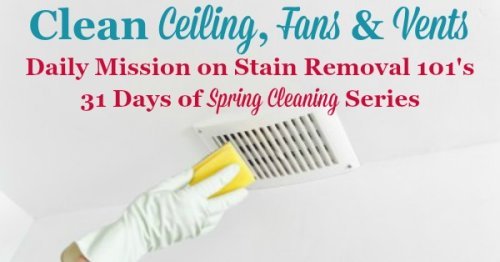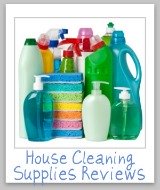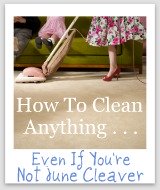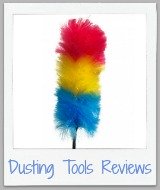Ceiling Cleaning Tips
Share Yours & Read Others
Here are tips, tricks and product recommendations for ceiling cleaning, to make this tedious chore easier and more effective.

How Often Should You Clean Ceilings?
I have cleaning your ceilings as a project for the annual 31 Days of Spring Cleaning Series here on the site because for most ceilings they just need to be cleaned once a year.
The only exceptions, typically, are your kitchen ceiling, which can get a bit dirtier because of cooking, and sometimes bathroom ceilings, if there is lots of splatters or mildew growth. These ceilings may need to be washed twice a year, or even quarterly.
If your home does tend to accumulate cobwebs in the ceiling corners though, you will need to deal with these a bit more frequently, such as quarterly.
Vacuuming Ceilings: Normally This Is Sufficient
For most ceilings they do actually get dusty with time, but that's about it, so instead of the chore of washing ceilings normally just vacuuming dust from your ceilings is more than sufficient.
All you need to do to vacuum your ceilings is use the dust brush attachment for your vacuum cleaner, an example of which is shown in the photo to the right. It is the circular attachment that has soft bristles on it, and will gently loosen the dust on your ceiling as it brushes across it and then the vacuum will suck it up.
The hard part of this task is not actually vacuuming, but reaching the ceiling with the attachment. Ideally you will have an extra long wand attachment which will allow you to reach the ceiling without having to stand on a ladder, while also holding up the vacuum. You can find all kinds of vacuum parts and accessories here, on Amazon.com, which can help you get the right parts if you don't currently have them. Just add your model into the search bar first, to make sure you find the part that works for your current vacuum cleaner.
If you don't, I suggest having someone help you with this task, to help you hold the ladder and also help manipulate and move the vacuum around, so that you can do it more safely. It totally isn't worth hurting yourself just to have a non-dusty ceiling.
Alternate Method For Dusting Ceilings: Extendable Duster
In addition, if you don't want to vacuum your ceilings you can also use a duster to remove dust (this also works well for removing those cobwebs I mentioned earlier). If you choose to use a duster make sure to use an extendable handle to make this task as easy for yourself as possible.
Ceiling Cleaning Extendable Dusters {Referral Links}

You can get more tips for reducing and removing dust in your home here.

How To Wash Greasy Ceilings In The Kitchen
Kitchen ceilings actually do get dirty because of grease accumulation due to cooking. These are the only ceilings I suggest you wash under normal circumstances, and even then, only wash them if it will not leave water spots.
It typically depends on the type of paint your ceiling has been painted with to know if washing will work for you. Test in an inconspicuous small area before doing the whole ceiling. Wipe the small spot with a sponge dampened (not dripping) with a solution of water and a few drops of all purpose cleaner. Then, rinse with another damp sponge, and let it dry. Only if the small area still looks good, no paint has been removed and there are no water spots, should you continue washing the rest of your ceiling.
Typically it is semigloss, high gloss latex, and oil based paints that can be washed well, or scrubbable latex paints.
Before washing, make sure to first vacuum the ceiling as instructed above, to get rid of loose dirt!
How To Clean Greasy Or Dirty Ceilings When You Can't Wash Them
If your ceiling can't be washed you can still clean it using a dry sponge. These sponges are designed to be used without water, and are made of foam.
To use them you rub the dry sponge onto the surface, in this case your ceiling, and it will pick up dirt. Then, periodically you rub away the dirty part of the sponge using sandpaper or cut it off with a knife, and wipe away more dirt until you've got the whole area clean.
Ceiling Cleaning Dry Sponge Cleaners {Referral Links}
Information Regarding Popcorn Ceilings & Safety Warning
Popcorn ceilings, also known as textured ceilings, are a pain to clean. They accumulate dust and debris, it seems to me, more easily than flat ceilings.
First, a safety warning about these textured ceilings. Did you know that homes where these ceilings were applied between the 1960's and early 1980's may contain asbestos? You do NOT want to be messing around with asbestos, so if your home meets these criteria before you attempt to do any type of cleaning you should have your home tested to see if your ceilings have asbestos or not.
Assuming it is safe to proceed, the best way to clean these ceilings is to vacuum them using the dust brush attachment. You do need to be careful though to not knock the textures with the attachment which will of course, knock them off and make it look uneven.
Tips From Other Readers {Plus Share Your Own}
Do you spend a lot of time cleaning your home and possessions? If so, you can use some good tips to help you get these chores done, so you can have some fun! Here are tips I've collected from readers like you, and from around the web to help you with these tasks.
Here are the tips submitted so far:
 Share Your Tips Here |
 Use Swiffer Sweeper For Cobwebs |
 Magic Eraser For Soot |
Everyone has a ceiling, and unfortunately they can get quite dirty.
Many times this dirtiness creeps up on us, because who just looks up and stares above them often, at least critically thinking about whether it could use a good scrubbing or not.
Also, the dirt often just slowly accumulates, and therefore it is rather uniform and hard to see how dingy it is until a small amount of it is cleaned.
Further, once we notice it, it is not convenient or easy to get to this surface to get it looking better.
Therefore, I would love to hear from you telling me how you clean this area of your home, with either tips and tricks or with product recommendations for this task.
Make sure to tell me what type of surface you've got on your ceiling, such as popcorn, tile, flat, etc. to help people find the tips most applicable to them!
Share Your Tips For How To Clean Ceiling
Ceilings sometimes need cleaning. So share your tips with me for how you do it.
If you like to use a particular type of cleaner, either homemade or purchased, or special cleaning equipment to get the job done well, please tell me about that too.
Finally, pictures aren't required, but are encouraged, especially if it helps show how you do something or the good results you had from using your tips.

Thanks For Visiting My Website: Grab Your Free Gift!

Hi, I'm Taylor, a busy mom with 3 kids, so I have lots of hands on experience with house cleaning, laundry and my fair share of spots, spills and other messy catastrophes. Thanks for visiting my site.
I update the website all the time with tips, tutorials, cleaning recipes, reviews of products from readers like you, and tests I've done on various cleaners, removers and laundry supplies.
I'd love to give you a gift! When you subscribe to my free weekly newsletter you will receive a free printable laundry stain removal chart that you can reference as needed.
I hope you enjoy this gift, and stop by again soon!
Related Pages You May Enjoy
House Cleaning Tips & Tricks For Busy Moms
House Cleaning Equipment & Tools Reviews
Go From Ceiling Cleaning Tips To Home Page
There are affiliate links on this page, and if you purchase a product through them I receive a small commission. Purchasing through my links costs you nothing extra, but helps support the free information provided on this site and my family. To learn more please see my product review disclosure statement.
CAUTION: This website is provided for informational purposes only. It is provided as is, without warranties or guarantees. Some stains and messes just won't come out, and are permanent. Further, some cleaning methods can harm your item, so if what you want to clean or launder is sentimental or expensive call a professional. See disclaimer of liability for more information.
Popular Tips
Let's Stay Connected!
Get Free Email Updates
(and get a FREE printable)
Related Pages
 Eco-Friendly Cleaners: Which Brands Work Best?
Eco-Friendly Cleaners: Which Brands Work Best?
 What Are Your Fave Cleaner Recipes?
What Are Your Fave Cleaner Recipes?
 Visit Household Management 101
Visit Household Management 101
 Visit Home Storage Solutions 101
Visit Home Storage Solutions 101











Share Your Comments, Tips & Ideas